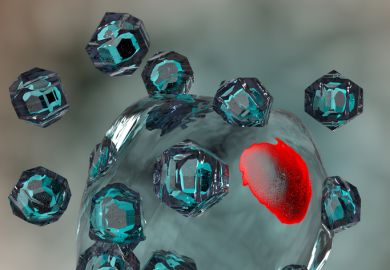On July 17 1986 the Premier mine in South Africa produced one of the great diamonds of all time, an irregular crystal of the "finest water" weighing 599 carats (120 grams, or just over 4 ounces). De Beers, the company that owned the mine, named it the Centenary diamond in celebration of their 100th year of mining in the region. A team of diamond cutters spent the next three years designing and building the equipment to fashion the stone. The work of cutting it took nine months and at the end of that time emerged a flawless gem of 3 carats with 247 facets and an unmatched brilliance and fire. What it is worth is anyone's guess.
A slightly larger raw diamond of 600 carats was discovered in India in the 13th century, and today we know this stone as the Koh-i-Noor, probably the world's most famous gem. It was acquired by the British after the second Sikh war in 1849, when it had already been cut down to 186 carats. Even that had to be reduced to its present 109 carats to remove a major flaw. Smaller it may be, but it is still priceless and now resides in the Queen Mother's crown in the Tower of London.
Other great diamonds are the blue Hope, now in the Smithsonian Institution, the Tiffany, the Cullinans, the Dresden Green, the Kasikci, the Shah Jahan, and the Sancy and the Regent, both in the Louvre. The Regent was bought by Philippe d'Orleans, regent of France in 1717 for Pounds 135,000 from Thomas Pitt, a merchant and president of Fort Madras, who acquired it in a rather shady deal for Pounds 20,000. Equating such sums to 1998 prices is difficult, but we would be talking tens of millions.
Why should these fragments of carbon even be worth a second glance, let alone a royal ransom? Rather strangely, diamond is less stable than the graphite form of this element, but the rate of conversion is immeasurably slow. Diamonds are almost indestructible and they have enriched the imagery of our language with their attributes, of beauty, hardness, coldness, purity, fire, wealth and brilliance. What they also offer is security, a hedge against inflation and, in times of crisis, they can easily be hidden and transported.
The Nature of Diamonds is a remarkable book, that is both an excellent source of information and a satisfying read. It covers its subject from all facets, starting with the origin of diamonds in the earth, and covering their discovery, their mining, the nature of diamonds themselves, their history, the skills of the diamond cutter, synthetic diamonds, the lure of diamond jewellery and the lore of diamonds in literature and films. Each chapter is written by an expert in the field, and the whole has been skilfully edited by George E. Harrow, curator of gems and minerals at the American Museum of Natural History. Harrow also contributed some chapters, including the first, "What is a diamond?", which deals in depth with the science of this form of carbon. Here I learned that diamonds are called "ice" not because they look like ice, but because when a large diamond is pressed against the lips it feels cold. The reason is its high thermal conductivity, which quickly drains heat to itself, a property that explains why diamond is being researched as a "heat sink" for microchips. Another interesting fact I discovered in this first chapter was that diamonds cannot be wetted by water, but they will attract oil. This was noted in 1896 by an employee of De Beers Consolidated Mines, who developed a technique for separating diamonds using a greasy table over which ground-up diamond ores were flushed. Only the diamonds stuck to the grease.
The second chapter, by Emmanuel Fritsch of the University of Nantes, France, is devoted to the colour of diamonds, and what causes them to be anything from brown (glamorised with names like "champagne" or "cognac") to the rare green, the even rarer orange, and the rarest of all, violet, which gets its colour from hydrogen atoms. Only about one diamond in a thousand is coloured and naturally such gems command high prices, especially among the few connoisseurs who collect them. Pink stones are sold at a special auction only once a year in Switzerland. Coloured diamonds can be produced by natural radiation in the earth, when they can take on light green or blue colour, or they can be artificially irradiated in a nuclear reactor, when they take on a spectrum of hues.
Most people still prefer their diamonds to be crystal clear and throughout history this and their unmistakable sparkle has been the main attraction. Chapters of The Nature of Diamonds are devoted to the role of diamonds in jewellery, and how in this century they have been successfully moved down-market, until almost everyone in developed countries today owns a diamond, be it in a ring, necklace, cuff link or wris****ch.
The second half of the book addresses the fashioning of diamonds, their incorporation in jewellery, and their marketing in this century. All make fascinating reading, and even the unexpected inclusion of a chapter entitled "Hollywood loves diamonds", by Maura Spiegel of the department of English and comparative literature at Columbia University, is used to make some valid points. Of course it was no accident that film studios found diamonds worthy of attention: the industry made them readily available for any producer or director who wished to feature them. So it was that Ninotchka, Gentlemen Prefer Blondes, Diamonds are Forever, The Pink Panther and even Alfred Hitchcock's To Catch a Thief sprinkled diamonds across the screen.
What I especially like about The Nature of Diamonds is the breadth of scholarship that has gone into producing it. Few books bring together people from such disparate disciplines as chemistry, physics, commerce, geology, history, literature, design, fashion, fine arts and the media, and at the same time have them all intelligible to the specialist and non-specialist alike. Perhaps, as a chemist, I am in a better position to understand the chapters that deal with the science of diamonds, but non-science readers can still enjoy these, just as I enjoyed so many of the other chapters, especially the historical ones, such as one by Harlow himself, entitled "Following the history of diamonds". In antiquity India was the only source of diamonds, and they were already known to the Greeks in the 6th century bc, who called them adamas (indomitable). They were then a source of mystery, and Aristotle himself helped perpetuate the myth of a fabulous Valley of Diamonds. According to him only Alexander the Great had ever reached this place, and even he was too afraid to look into the chasm from which they came, let alone descend into it, guarded as it was by fearful serpents.
Alexander only succeeded in obtaining a few diamonds from the valley by throwing down pieces of fatty meat to which some of the gems adhered. When birds swooped down and picked up the pieces of meat they brought diamonds out with them. What is rather curious is the ancient knowledge that the gemstones would have been attracted to the grease of the meat, a fact that was to be rediscovered over 2,000 years later.
In chapter six, Diana Scarisbrick of the Royal Society of Jewellery Historians takes a less fanciful journey through the history of diamonds in the past seven centuries. Here the evidence of the lure of diamonds is to be found in many a royal portrait, and the chapter ends with an essay on the diamond ring as a pledge of undying love. The solitaire diamond engagement ring was seen as the epitome of good taste by E. F. Cushing in 1926 in Culture and Good Manners, and although engagement to be married is no longer a meaningful step in relations between the sexes, the giving and receiving of such a ring is still regarded as strengthening the bond between two people.
There are few subjects that can unite so many branches of learning between its covers, and provide interesting reading in all of them. The Nature of Diamonds has succeeded superbly. Not only that, but it has the glamour of a coffee-table book with scores of fascinating illustrations. The authors and publishers are to be congratulated. It is well referenced and indexed and, despite being a multi-authored work, it has been admirably edited to ensure that whether the subject is alluvial mining or the binding of diamond-encrusted Russian bibles, it is informative and entertaining. If you cannot afford the real thing, and you want to give someone you love a jewel of a gift, then buy them this book - it is a gem.
John Emsley is science writer in residence, department of chemistry, University of Cambridge.
The Nature of Diamonds
Author - George E. Harlow
Editor - George E. Harlow
ISBN - 0 521 63083 X and 62935 7
Publisher - Cambridge University Press
Price - £19.95
Pages - 8
Register to continue
Why register?
- Registration is free and only takes a moment
- Once registered, you can read 3 articles a month
- Sign up for our newsletter
Subscribe
Or subscribe for unlimited access to:
- Unlimited access to news, views, insights & reviews
- Digital editions
- Digital access to THE’s university and college rankings analysis
Already registered or a current subscriber? Login



